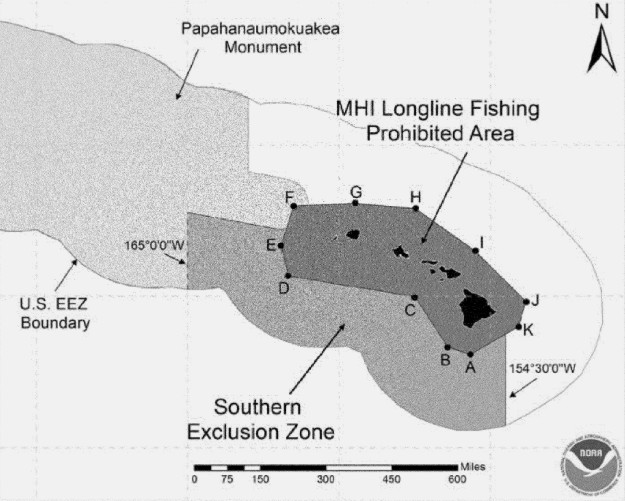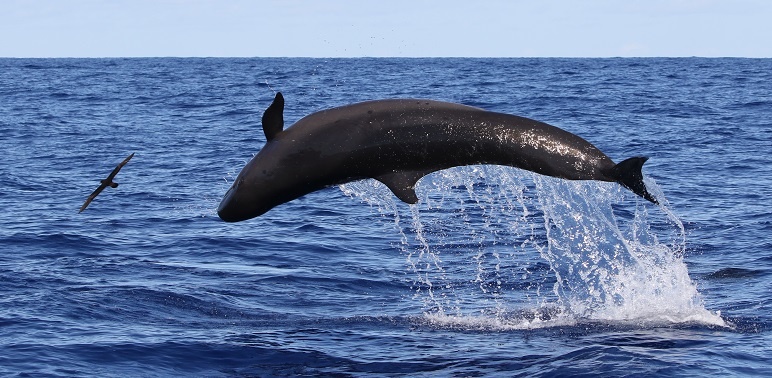Similar to the Hawai‘i shallow-set longline fishery’s incidental take of endangered loggerhead sea turtles, the Hawai‘i deep-set longline fishery just can’t seem to keep its interactions with false killer whales inside the 200-mile U.S. exclusive economic zone low enough to avoid triggering a closure.
A month after killing one false killer whale and seriously injuring another in federal waters in January, the fishery was shut out of a large swath of ocean south of the Main Hawaiian Islands for the second year in a row.
And because it was the second time in two years that the fishery hit its annual mortality and serious injury cap (M&SI), that closed area, known as the Southern Exclusion Zone (SEZ), will remain closed for the rest of the year, and potentially for the next two years.
At its meeting last month, the Western Pacific Fishery Management approved measures intended to help open the zone at the start of next year and to keep it from ever closing again.

How Serious is Serious?
According to a report by the council’s Scientific and Statistical Committee, there have been just three observed false killer whale mortalities out of the 50 or so observed interactions with the deep-set fishery since 2013. Of those interactions, NMFS has determined that two thirds of them resulted in serious injury.
Under the National Marine Fisheries Service’s rules, serious injuries to the whales are given the same weight as mortalities, and it takes just two mortalities or serious injuries within the federal waters around Hawai‘i to trigger the closure of the Southern Exclusion Zone. According to NMFS staff, a serious injury is any injury to the whale that is more than likely to result in its death.
But what constitutes a serious injury? And how likely is it to lead to the whale’s death? For years, the council has been questioning that, as well as asking for a new abundance estimate for the whales.
A hook in the mouth (unless it’s just the lip) is more likely than not to be considered a serious injury, regardless of how little trailing gear is attached, NMFS’s Kevin Brindock confirmed to the council last month. However, he added that his agency is considering new information that may affect how serious injuries are determined in the future.
To this, council member McGrew Rice suggested that false killer whales are a lot tougher than they’re being given credit for. One false killer whale found dead had six hooks inside it, he said, and “they determined it wasn’t the hooks that killed it.”
NMFS is expected to release a new abundance estimate for the population later this year. In the meantime, the council approved a staff recommendation to ask the agency to “consider developing probability-based serious injury determination criteria for false killer whales.”
At a scientific committee meeting held a week earlier, council staffer Asuka Ishizaki presented estimates of what M&SI numbers over the past several years would have been if the serious injury determinations had been prorated down a bit, similar to how NMFS treats injury determinations for larger cetaceans. Based on her calculations, in all years except 2018, the number of animals killed or seriously injured by the fleet came nowhere near the potential biological removal (PBR) limit.
In voicing his support for the council’s serious injury measure, NMFS’s Pacific Islands Regional Office administrator Mike Tosatto said he thought it was time his agency broadened its approach to M&SI determinations and suggested the measure could effect how they are done nationwide.
Record Highs
As the false killer whale take reduction plan is written, serious injury determinations pose a problem for the fishery only when they apply to interactions in federal waters. This, despite the fact that the goal of the plan is to reduce M&SI to zero throughout the fishery, which expends most of its effort in international waters.
The fishery has not only failed to reach that goal, it’s heading in the opposite direction. Brindock informed the council that last year, the fishery had a record number of observed false killer whale interactions, 13, four of which were within in federal waters. All four of those resulted in serious injuries and, as a result, the SEZ was closed from July though December.
While the SEZ has been closed again for the rest of this year, federal regulators will take into account any additional interactions that occur elsewhere inside the exclusive economic zone when evaluating when or whether to reopen the southern exclusion zone.
If the fishery can keep that number low, there is a good chance the SEZ could reopen at the start of next year, given that one of the four criteria for reopening it is if “the recent average M&SI level in the fishery within the open federal waters is below the PBR level.”
Based on the takes that have occurred so far this year, Ishizaki determined that the M&SI average for 2015-2019 is less than 7. The PBR level is currently 9.3.
Given that, the council voted to ask NMFS to establish a protocol for evaluating the five-year average estimated level of Main Hawaiian Island false killer whale M&SI for the 2015-2019 period to allow reopening of the SEZ on January 1, 2020, if that evaluation determines that the M&SI level inside federal waters remains below PBR.
Crew Training
When the false killer whale take reduction team met last year to discuss possible amendments to the plan to reduce the number of takes, as well as M&SI, it failed to reach a consensus on any measure.
After the whale interactions earlier this year, the team tried again via teleconference. According to Brindock, the team is looking at requiring stronger branch lines to increase the likelihood that whales will be able straighten the hooks and free themselves without gear attached.
Noting that crews are often cutting lines, rather than trying to encourage hook straightening, he said the team has also discussed improving captain and crew training and employing electronic monitoring on vessels to evaluate handling methods.
He added that the team is also considering “move-on” guidelines, since data have shown that moving a certain distance away from the whales decreases the possibility of interaction.
At the council meeting, members approved a recommendation that NMFS work with council staff to develop and implement an effective captain and crew training program to reduce the risk of M&SI, while also promoting crew safety.
The initial recommendation from council staff was to have NMFS implement the training on its own, but Tosatto pointed out that he could not commit agency resources to crew training, since it is not called for in the council’s fishery management plan.
“The council’s current plan only requires captain training, owners and captains, not crew,” he said, adding that mandatory crew training would be a serious undertaking and require serious funds.
Council member and American Samoa longliner Christinna Lutu-Sanchez added that mandating crew training would be difficult since there is a high turnover. Rice also pointed out that training efforts would have to account for the fact that crew members aren’t all fluent in English, since they come from Indonesia, the Philippines, Kiribati, and elsewhere.
“We understand that. … We’re going to do the best job that we can. We’ll work it out,” council executive director Kitty Simonds replied.
– Teresa Dawson


Leave a Reply